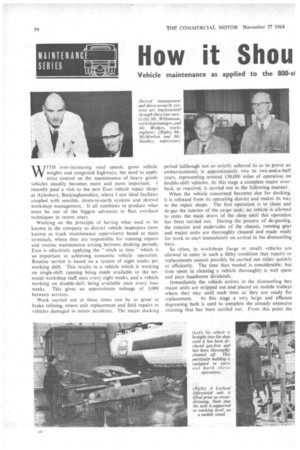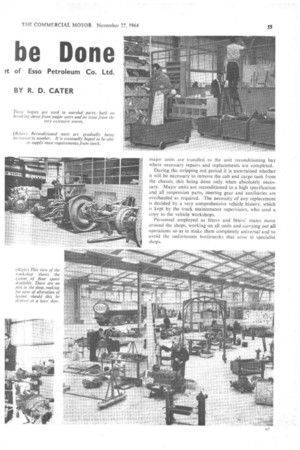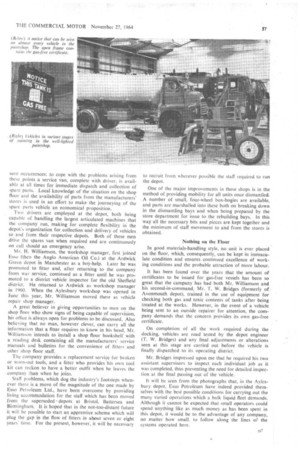How it Shou be Done
Page 56

Page 57

Page 58

Page 59

If you've noticed an error in this article please click here to report it so we can fix it.
WITH ever-increasing road speeds, gross vehicle weights and congested highways, the need to apply strict control on the maintenance of heavy goods vehicles steadily becomes more and more important. I recently paid a visit to the new Esso vehicle repair shops at Aylesbury, Buckinghamshire, where I saw ideal facilities coupled with sensible, down-to-earth systems and shrewd workshop management. It all combines to produce what must be one of the biggest advances in fleet overhaul techniques in recent years.
Working on the principle of having what used to be known in the company as district vehicle inspectors (now known as truck maintenance supervisors) based at main terminals, where they are responsible for running repairs and routine maintenance arising between docking periods, Esso is effectively applying the "stitch in time which is so important in achieving economic vehicle operation. Routine service is based on a system of eight weeks per working shift. This results in a vehicle which is working on single-shift running being made available to the terminal workshop staff once every eight weeks, and a vehicle working on double-shift being available once every four weeks. This gives an approximate mileage of 3.000 between services..
Work carried out at these times can be as great as brake relining, minor unit replacement and field repairs to vehicles damaged in minor accidents. The major docking period (although not so strictly adhered to as to prove an embarrassment) is approximately two to two-and-a-half years, representing around 150,000 miles of operation on double-shift vehicles. At this stage a complete major overhaul, as required, is carried out in the following manner.
When the vehicle concerned becomes due for docking, it is released from its operating district and makes its way to the repair shops. The first operation is to clean and de-gas the interior of the cargo tank; no vehicle is allowed to enter the main doors of the shop until this operation has been carried out. During the process of de-gassing, the exterior and undersides of the chassis, running gear and major units are thoroughly cleaned and made ready for work to start immediately on arrival in the dismantling bays.
So often, in workshops (large or small) vehicles are allowed to enter in such a filthy condition that repairs or replacements cannot possibly be carried out either quickly or efficiently. The time thus wasted is considerable; but time spent in cleaning a vehicle thoroughly is well spent and pays handsome dividends.
Immediately the vehicle arrives in the dismantling bay major units are stripped out and placed on mobile trolleys where they stay until such 'time as they are ready for replacement. At this stage a very large and efficient degreasing bath is used to complete the already extensive cleaning that has been carried out. From this point the major units are trundled to the unit reconditioning bay where necessary repairs and replacements are completed.
During the stripping out period it is ascertained whether it will be necessary to remove the cab and cargo tank from the chassis, this being done only when absolutely necessary. Major units are reconditioned to a high specification and all suspension parts, steering gear and auxiliaries are overhauled as required. The necessity of any replacement is decided by a very comprehensive vehicle history, which is kept by the truck maintenance supervisors, who send a copy to the vehicle workshops.
Personnel employed as fitters and fitters' mates move around the shops, working on all units and carrying out all operations so as to make them completely universal and to avoid the unfortunate bottlenecks that arise in specialist shops.
It is the eventual intention that stocks of major units will be held in such numbers as to allow for immediate replacement, so enabling a very quick turn-round of vehicles being docked. At the moment the organization is progressing steadily, building up its stock of major service units. When this build-up is completed it will be possible to supply all the outlying depots for which it is responsible with necessary reconditioned units on demand. From that point units will be overhauled on a production basis, so cutting down the cost in this field of operations.
An unusual method of providing staff for the vehicle paint shops at this depot is in existence. Although Esso furnish all the plant and equipment, the labour, painters, signwriters, labourers and other staff are provided by an outside company. This gives a very much needed lever to the depot manager when paint jobs are turned out below the required standard, and does not result in a constant changing of personnel (which makes for frequent supervisory visits).
For the purposes of recording the work carried out at the depot, reconditioning is split into seven numbered
operations. These are in order: engine, clutch and gearbox; front-axle, steering and servo; rear-axle, prop-shafts and turntables; electrical; bodywork; tank; and paintwork. When one of these operations has been carried out or is being carried out by a fitter, he merely marks in the column provided on his daily timesheet that he has been engaged, for instance, on operation 3 on vehicle number 6209. Then, in the daily columns throughout the week he fills in the amount of hours he has devoted to this job. It will be seen that this method cuts down considerably the amount of scribbling that a fitter is required to do, and also provides an instant guide to the cost of labour involved on any one job. Column two on the timesheet bears order numbers for material used.
Special tools are kept on racks in the workshop and are the responsibility of one of the two assistant supervisors, thus preventing a considerable amount of lost labour time by fitters having to queue at the stores waiting for special tools to be issued: For the same reasons eXpendable materials, such as joint-packing, sheet cork and Hallite, are also kept on these racks.
Fuel injection equipment is serviced by an outside agency, factory-reconditioned injectors being used throughout. Basically, maker-recommended fuel filter elements' are used, and these are changed at alternative services in the case of single-shift vehicles and at each service on double-shift vehicles. When a vehicle is docked all filters are changed irrespective of service.
Determining the spares holdings in any repair shop presents one big headache. The method that Esso use—and claim to be extremely successful—is to produce an overhauling' programme for the corning year. From this the spares requirement is easily determined and can be preordered in plenty of time to avoid delays on the shop floor.
It is recognized that this does not complete the picture with regard to breakdowns, accidents and other unfore seen occurrences: to cope with the problems arising from these points a service van, complete with driver, is available at all times for immediate dispatch and collection of spare parts. Local knowledge of the situation on the shop floor and the availability of parts from the manufacturers' stores is used in an effort to make the journeying of the spare parts vehicle an economical proposition.
Two drivers are employed at the depot, both being capable of handling the largest articulated machines that the company run, making for complete flexibility in the depot's organization for collection and delivery of vehicles to and from their respective depots. Both of these men drive the spares van when required and are continuously on call should an emergency arise.
Mr. H. Williamson. the workshop manager, first joined Esso (then the Anglo American Oil Co.) at the Ardwick Green depot in Manchester as a boy-help. Later he was promoted to fitter and, after returning to the company from war service, continued as a fitter until he was promoted to a district vehicle inspector for the old Sheffield district. He returned to Ardwick as workshop manager in 1960. When the Aylesbury workshop was opened in June this year, Mr. Williamson moved there as vehicle repair shop manager.
A great believer in giving opportunities to men on the shop floor who show signs of being capable of supervision, his office is always open for problems to be discussed. Also believing that no man, however clever, can carry all the information that a fitter requires to know in his head, Mr. Williamson intends to install a shop floor bookshelf with a reading desk containing all the manufacturers' service manuals and bulletins for the convenience of fitters and other shop floor staff.
The company provides a replacement service for broken or worn-out tools, and a fitter who provides his own tool kit can reckon to have a better outfit when he leaves the company than when he joins.
Staff problems, which dog the industry's footsteps whenever there is a move of the magnitude of the one made by Esso Petroleum Ltd., have been overcome by providing living accommodation for the staff which has been moved from the supersededdepots at Bristol, Battersea and Birmingham. It is hoped that in the not-too-distant future it will be possible to start an apprentice scheme which will plug the gap in the flow of fitters in about seven or eight years time. For the present, however, it will be necessary to recruit from wherever possible the staff required to run the depot.
One of the major improvements in these shops is in the method of providing mobility for all units once dismantled. A number of small, four-wheel box-bogies are available, and parts are marshalled into these both on breaking down in the dismantling bays and when being prepared by the store department for issue to the rebuilding bays. In this way all the necessary bits and pieces are kept together and the minimum of staff movement to and from the stores is obtained.
Nothing on the Floor In good materials-handling style, no unit is ever placed on the floor, which, consequently, can be kept in immaculate condition and ensures continued excellence of working conditions and the probable attraction of more labour.
It has been found over the years that the amount of certificates to be issued for gas-free vessels has been so great that the campany has had both Mr. Williamson and his second-in-command, Mr. T. W. Bridges (formerly of Avonmouth depot), trained in the use of equipment for checking both gas and toxic contents of tanks after being treated at the works. However, in the event of a vehicle being sent to an outside repairer for attention, the company demands that the concern provides its own gas-free certificate.
On completion of all the work required during the docking, vehicles are road tested by the depot engineer (T. W. Bridges) and any final adjustments or alterations seen at this stage are carried out before the vehicle is finally dispatehed to its operating district Mr. Bridges impressed upon me that he required his two assistant supervisors to inspect each individual job as it • was completed, thus preventing the need for detailed inspection at the final passing out of the vehicle.
It will be see-n from the photographs that, in the Aylesbury depot, Esso Petroleum have indeed provided themselves with the best possible conditions for carrying out the many varied operations which a bulk liquid fleet demands. Although it cannot be expected that small operators could spend anything like as much money as has been spent in this depot, it would be to the advantage of any company, no matter how small. to follow along the lines of the systems operated here.
















































































































